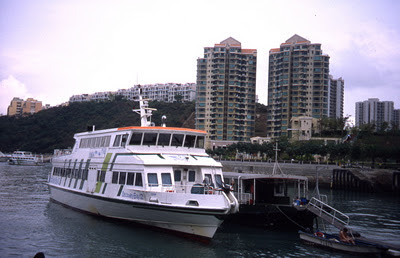June 2005 Lantau and Peng Chau are two islands off Hong Kong. While Peng Chau is a fascinating little traditional Chinese fishing island full of elderly retirees, Discovery Bay where we stayed on Lantau is a completely synthetic residential enclave for international expats to live in complete isolation from Asian realities.


The wider Lantau is an island of contrasts. Originally the site of fishing villages, the island has been developed in recent years with the construction of Tung Chung New Town on its north-western coast. It is named after its high peak, has nature parks, and a famous stilt village at Tai O, a fishing town located in the northwest of Lantau Island which is more than three centuries old, and retains most of its historical setting such as waterways, stilt houses and fishing boats.

We arrived in the evening by ferry from Macau via Hong Kong island to the seaward side of Lantau to Discovery Bay harbour and my friends live in an apartment, but you can also get to Lantau on the metro past Disneyland and the airport followed by a bus over the hill.
 High rise at Tung Chung New Town metro stop
High rise at Tung Chung New Town metro stopThere are no private vehicles in Discovery Bay apart from the endemic golf carts which guarantee no one travels fast than a casual walking pace. There is also next to nothing to do except sip drinks in the central shopping area, or go sailing. Peng Chau proved much more entertaining for us! (see below).





The next day we took a ferry to Peng Chau.



You arrive in a little port with an adjacent village with some well known little Chines shrines and tiny arcades stuffed with more items than you can possibly imagine, with a mix of fishermen and elder Chines people who either still live here or have retired to the relative quietness an openness of Peng Chau by comparison with Hong Kong itself.




Tin Hau Temple boasts a long history as shown by the whale bones that are more than 400 years old and the ancient bell that was made 6 years before restoration of the temple in 1798. The history of the original temple has yet to be traced. According to legend Tin Hau Goddess was born in the Song Dynasty (960-1279A.C.) to a fisherman surnamed Lam in Fuzhou. As a child she was intelligent, knowledgeable in astrology and was and able to forecast the climate. She also practiced medicine and saved countless people. After her death, she was worshiped as Tin Hau Goddess or Ma Jo Sea Goddess and had many followers around the South China Sea.



KamFa Temple or The Golden Flower Shrine sits under the banyan tree on Wing On Street, honouring Lady Golden Flower. According to the legend, it was in 1762, the 27th year of Emperor Qianlong of the Qing Dynasty and a villager named Lai kwok-man went to Peng Chau looking for Chinese herbs for his wife. He anchored his boat near the banyan tree and prayed to the giant rock next to it. Later, Lai’s wife recovered. The couple got an inspiration from the Lady Golden Flower they built a shrine here to honour her.
The Goddess KamFa is one of the great Gods in heaven, among which are the all merciful Avalokitesvara (Kunyum) and Tin Hau Yuen Gwen, the great guardian to all people and land. According to legend KamFa Goddess was the daughter of a martial arts teaching official in the Tang Dynasty. She was gifted with high intellect, integrity and loyalty. She secretly learned Kung-Fu from her father at a very young age. Achieving the essence of art forms, she adapted in both martial arts and literature. At the time corruption was rampant, people subdued to harsh lives. KamFa Goddess made use of her martial arts skills and often went alone robbing the rich to give to the poor. People praised her deeply for these deeds. One day she was chased by government officials that forced her to hide in a cave in the mountain. Not knowing her whereabouts, her father went searching for her everywhere with those whom she had helped. They finally found the cave entrance but not a trace of the beloved daughter in the cave. All they could see was a human fossil. People immediately knelt down and prayed naming, her “Goddess of Saviour of the World”.





The island is topped by steep forested Finger Hill with a wild little nature park and great views of the Hong Kong seaboard. There is a curving street that climbs to the park steps. The air was sweet with nectar and full various species of of black and white butterfly, and the odd lizard scuttling into crevices as we approached.




There are also tortuous little informal ways back into town which wind through some of the 'illegal' squatter houses that continue to exist as dwellings tucked on the edge of the steep coastling, where you have to literally step into someones living space to pass through.













No comments:
Post a Comment